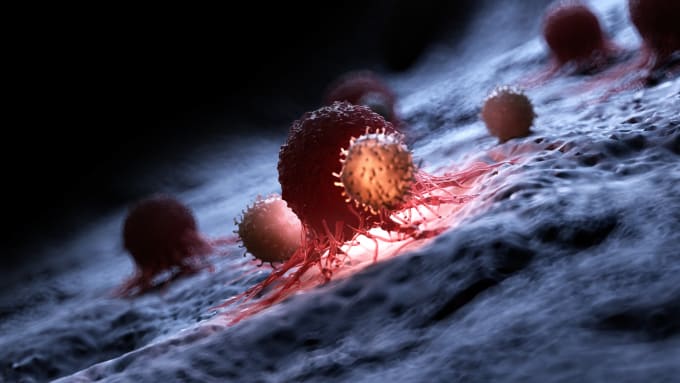Single cell analysis reveals rare population of cells that contribute to CD19 CAR T-cell therapy neurotoxicity
From February 8–12, 2021, 10x Genomics will host a Global Cell Therapy Virtual Symposium, which will bring together leading scientists in the cancer immunotherapy space to share their findings using single cell technologies. In this blog post, we highlight work from one of the event’s featured speakers, Ansuman Satpathy, MD, PhD, whose lab recently published research revealing a new mechanism for how CD19 CAR T-cell therapy may cause neurotoxicity in a subset of patients with B-cell malignancies.

The path from research to effective cell therapies requires innovative approaches—increasingly, those approaches are demanding single cell technologies. To that end, 10x Genomics will host a Global Cell Therapy Virtual Symposium, to be held February 8–12, 2021, that will bring our global community together virtually to share research findings in the field of immuno-oncology. Leading scientists who are pushing the boundaries of cancer immunotherapy research will be able to discuss how single cell resolution is driving new insights into the mechanisms of efficacy and toxicity of immune cell therapies.
In an effort to promote some promising research in the field of cancer immunotherapy, we are highlighting recently published research from the lab of Ansuman Satpathy, MD, PhD, a Parker Bridge Fellow and assistant professor at Stanford University School of Medicine, who is a featured speaker at the upcoming symposium. Dr. Satpathy’s lab used 10x Genomics single cell tools to further our understanding of CD19 CAR T-cell therapy, specifically, the mechanisms leading to neurotoxicity in a subset of patients treated for B-cell cancers.
Existing immunotherapies for treating cancer, including checkpoint inhibitors and monoclonal antibodies, have shown success for some tumor types, but one of the most promising is chimeric antigen receptor (CAR) T-cell therapy. However, while CAR T cells are an approved therapy for some hematological cancers, they have not shown efficacy for solid tumors. Challenges to using CAR T-cell therapies include variable patient response, resistance to treatment, and development of on-target, off-tissue toxicities. Despite the early success in hematological cancers, some patients experience severe neurotoxic side effects after infusion, the mechanism of which has remained elusive in the field for a decade.
High-resolution picture links rare brain cell population to neurotoxic response
One type of CAR T-cell therapy targets CD19 antigen, a protein located on the surface of B cells. When targeted to the CD19 antigen, CAR T cells effectively track and kill malignant cells in B-cell cancers like leukemia, lymphoma, and multiple myeloma. However, some patients experience neurotoxicity as an effect of treatment. While CD19 was thought to only be expressed by B cells, results of the study from the Satpathy lab shows that other cell populations express low levels of CD19. This has important implications for the design of CD19-directed immunotherapies beyond CAR T, and provides a case for better understanding the expression of immunotherapy targets in unexpected cell populations in the body.
The Satpathy lab is generally interested in using single cell multiomic technologies to understand cancer immunity, both natively and in response to therapeutic intervention. In previous work, they used single cell techniques to uncover how T-cell behavior evolves under checkpoint blockade therapy—it was this work that led Dr. Satpathy to establish his own lab. One of the lab’s first studies, published in the journal Cell and titled, “Single-Cell Analyses Identify Brain Mural Cells Expressing CD19 as Potential Off-Tumor Targets for CAR-T Immunotherapies,” discovered that CD19 exists not just in B cells but in a rare type of brain cell called mural cells, which line blood vessels and help protect the blood-brain barrier.
The team used scRNA-seq data from 2,364 human prefrontal cortex cells to identify CD19 expression in mural cells, including pericytes as well as vascular smooth muscle cells (both are types of mural cells). Mouse models showed that mouse mural cells exhibit lower levels of CD19 expression, suggesting the importance of using human tissues to study the efficacy of CAR T-cell therapies. Overall, their findings suggest a mechanism for neurotoxicity in CD19 CAR T-cell therapies with implications for improving the design of CD19 and other CAR T-cell immunotherapies.
Importantly, the study found that the pericytes expressing CD19 make up only 0.6% of all cells in the brain. Despite their low abundance in the brain, CD19 CAR T cells were able to traffic to the brain and cause fatal toxicity in some patients. This underscores the importance of using tools that are sensitive enough to detect the expression of ultra-rare cell populations in an unbiased manner. Because we don’t yet know what tissues might harbor cell populations expressing low levels of CAR T target antigens, creating atlases of single cell expression data across all tissues will be an important tool to thwart on-target, off-tissue toxicities.
Join leading scientists pushing the boundaries of cancer immunotherapy research for a week of engaging presentations as well as a live discussion panel at the 10x Genomics Global Cell Therapy Virtual Symposium.** Register today.**
